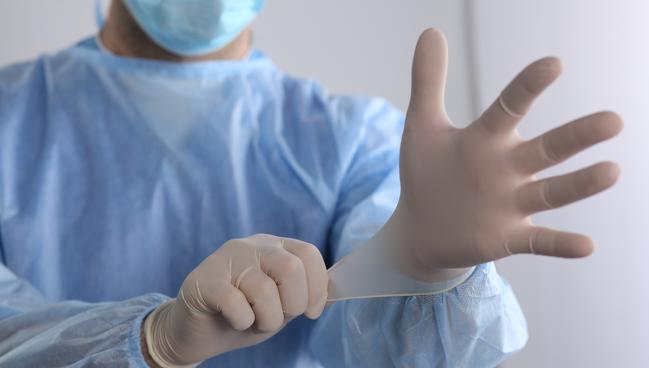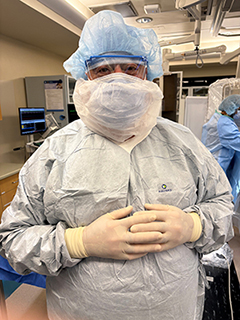Cath Lab Attire: ‘Dress Up and Shut Up’ or Time for a Change?
Morton Kern, MD, often engages his colleagues via email in brief, informal dialogue on clinically relevant topics in cardiology.

 Morton Kern, MD, of VA Long Beach Healthcare System and University of California, Irvine, often engages his colleagues via email in brief, informal dialogue on clinically relevant topics in interventional cardiology. With permission from the participants, TCTMD presents their conversations for the benefit of the cardiology community. Your feedback is welcome—feel free to comment at the bottom of the page.
Morton Kern, MD, of VA Long Beach Healthcare System and University of California, Irvine, often engages his colleagues via email in brief, informal dialogue on clinically relevant topics in interventional cardiology. With permission from the participants, TCTMD presents their conversations for the benefit of the cardiology community. Your feedback is welcome—feel free to comment at the bottom of the page.
Colleagues,
Dr. Seto, in his question below, is concerned that regulations for cath lab sterility have increased over the years without data to support the changes. While seemingly a small thing, it’s bothersome, to say the least.
We previously addressed hats and masks a decade ago in the Cath Lab Digest. Is it time to state a louder objection?
Arnold Seto, MD (Long Beach VA Medical Center, CA):
Our cath lab staff have been recently instructed that the following should occur (variably attributed to Association of peri Operative Registered Nurses [AORN] and Joint Commission on Accreditation of Healthcare Organizations [JCAHO] guidelines):
- All cath lab lead should be wiped down with alcohol wipes after every patient encounter/cath procedure
- All facial hair needs to be covered with a beard cover (A colleague of mine said that at his hospital he was told he needed to cover any visible facial hair, even his 5 o’clock shadow)
I note that the American College of Surgeons got into a tiff in 2019 with the AORN about the AORN recommendation that traditional skullcaps were not to be worn, and only bouffant hairnets were appropriate, whereas the evidence showed that the bouffant hairnets were actually associated with more particulate contamination.
Central to all of these rules is a lack of evidence. At what point does common sense/evidence prevail?
Bonnie Weiner, MD (Saint Vincent Hospital, Worcester, MA):
Common sense left this discussion a long time ago. Hats and masks really only protect us, not patients. Scrubs only keep our clothes clean and sweat free. Our lead is covered with a gown, so what good does wiping it down do? I spent over 20 years cathing in street clothes (not scrubs) covered with lead and a gown and never had a patient-related infection.
This whole argument is nuts, with absolutely no science to support any regulations. I do understand where larger open wounds such as EP device placements and some structural procedures may be different, but a small percutaneous puncture (and even those for structural procedures are getting smaller) is no different a risk than an IV placement, and we don’t have people gowned and masked to do that.
Lloyd Klein, MD (UCSF Medical Center, San Francisco, CA):
I agree with Bonnie 100%. This debate has nothing to do with science or patient care and everything to do with local control and power. If you don’t have an infection problem, then why is it a problem? If you do have an infection problem, the reasons need to be identified and resolved.
Gurpreet S. Sandhu, MD, PhD (Mayo Clinic, Rochester, MN):
Guidance for surgical ORs should not be misapplied to the current high-quality and safe cath lab procedural practices. I was part of a group that reviewed this several years ago and everything needs a commonsense approach, and this is best done by individual institutions. A very large, flowing beard should require some type of sensible cover in an OR setting, but eyelashes, eyebrows, stubble, short beards, mustaches, and hair visible at necklines doesn’t cause any issues if one is using standard surgical caps and the regular surgical masks.
Stephen Ramee, MD (LSU Health Sciences Center, New Orleans, LA):
Bonnie is correct. The rarest of the senses is common sense, as my story illustrates.
In 2018, a patient fell on the psych ward in our hospital and was taken to the ER. While there, another patient was admitted to his empty bed. The psych unit was full and there were no more psych beds in our area, so when his ER stay was finished, the patient was transferred to a hospital 300 miles away without notifying his family. The family filed a complaint with the Centers for Medicare & Medicaid Services (CMS).
Our hospital hired a “consultant” who used to work at CMS to review all our hospital procedures prior to the expected audit. One of the recommendations that came out of that pre-audit review was that surgeons’ caps could no longer be used in the hospital and that all personnel in the hospital ORs, including the cath lab, must wear bouffant caps. We had never had an infection in the cath lab. Neither of these recommendations, as your writer noted, were based in common sense.
So, because a psych patient fell and got injured and lost his bed, we in the cath lab had to wear bouffant caps for years until the surgeon rebellion restored common sense.
Timothy D. Henry, MD (The Christ Hospital, Cincinnati, OH):
This is such an excellent question, and the answers are all consistent. We base our careers on data, and this is an area where decisions are in contrast to the data. Usually this involves doing things that make us more uncomfortable, but make no difference to patients, and are sometimes actually counterproductive.
An absolute lack of common sense is unfortunately too common.
This is a problem when the regulators are not familiar with (or open to listening to) the data. Another excellent example right now is the response of states to radiation safety. There’s shocking variability from state to state that’s counterproductive to interventional cardiologist health.
Ohio is actually quite flexible, but recently the Ohio Department of Health (ODH) came for a survey and visited the cath lab. We have been lead free for 6 months and do ongoing monitoring and know that it is successful. We also have excellent protocols in place. ODH did not interfere with that, but I had a nice conversation with the inspector, and I was absolutely shocked that they knew nothing about the problem or the issue. These are people making the decisions on what we do with no knowledge of the data.
Kreton O. Mavromatis, MD (VA Atlanta Health Care System, GA):
I agree with the sentiment that we are being required to do a lot of unnecessary maneuvers for the sake of infection control during our cath procedures. But I recently realized that the practicalities of bucking these requirements are formidable.
On a recent review of our SOP for infection control in our cath labs, we realized the same staff perform everything from left- and right-heart caths, to pacemaker implantations, to left atrial appendage occlusions on the same day in the same rooms, as well as TAVRs with surgeons and surgical staff present in hybrid ORs. We believed that having different standards for different procedures, involving a variety of staff in the various locations—falling under different jurisdictions—was a recipe for noncompliance, or the perception of noncompliance.
Sadly, the question for us was: was it worth the fight and effort?
Henry:
ORs are different than cath labs and electrophysiology labs—it is not that complicated.
I cannot recall a cath lab-related infection ever in my career. The only infections were urinary tract infections from mandatory foleys for “long procedures,” another crazy mandated protocol that made no sense and we finally got rid of after showing harm.
David Cohen, MD (St. Francis Hospital, Roslyn, NY):
1. The only really bad “cath lab” infection I can remember was a horrible, infected groin after TAVR, which occurred in the era when TAVR access was by cutdown.
2. All this reminds me of my all-time favorite Don Baim quote (which I always make sure to teach our fellows): “Sterility in the cath lab is somewhere between the OR and the cafeteria.”
J. Jeffrey Marshall, MD (Northside Hospital Heart Institute, Lawrenceville, GA):
Wow! We all miss Dr. Baim’s commonsense wisdom. A real loss for cath labs and interventional cardiologists.
I strongly agree with all that has been stated about these farcical groups, like AORN and others that can’t spell cath lab, trying to tell us what we should do with no supporting data in the place we’ve worked every day for five-plus decades.
I think the Society of Cardiovascular Angiography and Interventions, and any other organizations that care about the cath lab environment, should push back hard on these attacks with new statements and guidelines (since there are no hard data) to keep the insane from running the asylum. The surgeons did it with the crazy cap issue, and we should too.
Enough is enough.
Peter Block, MD (Emory University, Atlanta, GA):
What are we discussing here?
Do we really want to go to the mat over whether wearing a bouffant hat is better than a cap? If this is about “others” telling us what to do without data, that is one thing. We all agree that is unreasonable. But I sense there is an undercurrent of a desire to minimize protection for both patients and caregivers because putting things on is a pain in the a** (aka PIA). I plead guilty to walking into a lab, putting on gloves only, and finding a difficult RCA ostium for a fellow—but I probably shouldn’t. (And there’s no data on that either).
A lot of this discussion had its origin in the early days of live cases when extraneous emcees in street clothes felt compelled to rub shoulders with operators. Honestly, I think we have no clue how we should dress in the lab—but we do know that we all shed lots of bad things from ourselves as we simply stand around. That patients seem safe from infection in the cath lab is likely only partially true, and that is as non-data driven as everything else in this discussion. Here’s a question: how long does it take alpha strep to fire up full-blown prosthetic valve endocarditis after TAVR if it is dropped onto the valve during prep? I suspect the cath lab is rarely fingered (no pun intended) as the culprit. I worry that being too “liberal” with discarding covering is not such a great idea and we need to have concern as we place more and more foreign bodies in the circulation. Putting on a cap and hiding a beard still seems like a good idea —but conventional wisdom is also my least favorite phrase.
Carl Tommaso, MD (Retired, Dallas, TX):
In my 40 years (many before advent of radial approach), I had two patients with groin infections, both of whom took a bath or hot tub immediately after discharge. Written discharge instructions noted no bath and discharge RN remembered instructing the patient, and I remember the hot tub guy asked me if he could use his hot tub and I told him no.
Duane Pinto, MD (Beth Israel Deaconess Medical Center and JenaValve Technology, Boston, MA):
I wear the bouffant cap because it’s faster to put on and that’s what many of my attendings did. Also, I find the ventilation better. I don’t take off my wedding ring in TAVR, because my finger is too fat now.
The Bottom Line From Mort Kern

While the attire and rules sometimes go against common sense in a data-free zone, cath sterility and best patient care (perceptions) trump most alternatives. Any attempt to return to the ‘good’ old days of street clothes topped by a grown and gloves is futile, if not silly.
Although it’s inconvenient to accede to the apparently unnecessary and illogical demands of adding yet another protective piece of gear (eg, most recently full face shields and facial hair covers), we have no choice but to comply. Peter Block again cut to the quick: is this worth the effort to change it? Despite my irritation every time I put on a face shield, I cannot fight city hall. I think most of my colleagues above would agree that only actions taken by our professional society would carry enough weight to bring logic to the cath lab attire issue. I guess I’ll have to dress up and shut up for now.
Comments